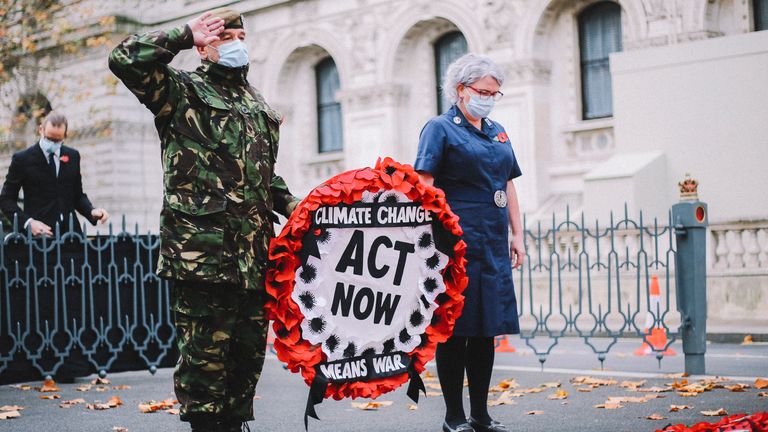Extinction Rebellion criticised for 'profoundly disrespectful' protest at Cenotaph on Remembrance Day
IT WAS ANYTHING BUT
The Labour leader's spokesman says "no-one can doubt how serious the climate crisis is" but the protest was "wrong"
IT WAS ANYTHING BUT
The Labour leader's spokesman says "no-one can doubt how serious the climate crisis is" but the protest was "wrong"
PROTEST IS NEVER WRONG INCLUDING BURNING THE FLAG
By Alan McGuinness, political reporter
SKY NEWS RIGHT WING VIEWS
Wednesday 11 November 2020 UK
EXTINCTION REBELLION

Play Video - Extinction Rebellion's Cenotaph protest
The action has drawn widespread criticism for demonstrating a lack of respect to the fallen.
Extinction Rebellion has been condemned by politicians for staging a protest at the Cenotaph on Remembrance Day.
Protesters from the group unveiled a banner stating "Honour Their Sacrifice, Climate Change Means War" at the memorial on Whitehall.
British Army veteran and Extinction Rebellion member Donald Bell, who helped display the banner, observed a two-minute silence before hanging a wreath of poppies with the message "Act now".

By Alan McGuinness, political reporter
SKY NEWS RIGHT WING VIEWS
Wednesday 11 November 2020 UK
EXTINCTION REBELLION

Play Video - Extinction Rebellion's Cenotaph protest
The action has drawn widespread criticism for demonstrating a lack of respect to the fallen.
Extinction Rebellion has been condemned by politicians for staging a protest at the Cenotaph on Remembrance Day.
Protesters from the group unveiled a banner stating "Honour Their Sacrifice, Climate Change Means War" at the memorial on Whitehall.
British Army veteran and Extinction Rebellion member Donald Bell, who helped display the banner, observed a two-minute silence before hanging a wreath of poppies with the message "Act now".

British Army veteran and Extinction Rebellion member Donald Bell hangs a wreath of poppies with the message 'Act now'
The protest has attracted criticism, with Boris Johnson's spokesman saying it was "profoundly disrespectful".
"The Cenotaph is a memorial to those who fought and died to preserve all our freedoms," the prime minister's spokesman said.
"On today, of all days, when we join together to pay tribute to our war dead, this action was profoundly disrespectful."
Veterans minister Johnny Mercer said: "Climate change matters, but the Cenotaph on Armistice day should be about one thing only - showing our respect for the sacrifice of the fallen who died to protect our freedoms today."
A spokesman for the Royal British Legion said: "While we respect the right of others to express their opinions within the law, we believe the Poppy Appeal is a time for remembrance, and not for political protest."
And Sir Keir Starmer joined the criticism, with the Labour leader's spokesman telling journalists: "No-one can doubt how serious the climate crisis is but the protests at the Cenotaph today were wrong and we do not support them."
Mr Bell, who completed four tours in Northern Ireland during the Troubles, said he knew he would be criticised for his actions.
"I knew that I would be accused of being disrespectful and hated by many for speaking out in this way," the 64-year-old said.
"Remembrance Day is never an easy time for veterans and this was not an easy decision for me to make.
"This government's own climate advisers, the Committee on Climate Change, said last year that they have a 'Dad's Army' approach to protecting British people from the impacts of climate change.
"Their report in June this year showed that the government has failed to meet all but two of the 31 milestones it set itself for reducing emissions.
"This government is criminally negligent and young people today will pay the price for their failure."
The protest has attracted criticism, with Boris Johnson's spokesman saying it was "profoundly disrespectful".
"The Cenotaph is a memorial to those who fought and died to preserve all our freedoms," the prime minister's spokesman said.
"On today, of all days, when we join together to pay tribute to our war dead, this action was profoundly disrespectful."
Veterans minister Johnny Mercer said: "Climate change matters, but the Cenotaph on Armistice day should be about one thing only - showing our respect for the sacrifice of the fallen who died to protect our freedoms today."
A spokesman for the Royal British Legion said: "While we respect the right of others to express their opinions within the law, we believe the Poppy Appeal is a time for remembrance, and not for political protest."
And Sir Keir Starmer joined the criticism, with the Labour leader's spokesman telling journalists: "No-one can doubt how serious the climate crisis is but the protests at the Cenotaph today were wrong and we do not support them."
Mr Bell, who completed four tours in Northern Ireland during the Troubles, said he knew he would be criticised for his actions.
"I knew that I would be accused of being disrespectful and hated by many for speaking out in this way," the 64-year-old said.
"Remembrance Day is never an easy time for veterans and this was not an easy decision for me to make.
"This government's own climate advisers, the Committee on Climate Change, said last year that they have a 'Dad's Army' approach to protecting British people from the impacts of climate change.
"Their report in June this year showed that the government has failed to meet all but two of the 31 milestones it set itself for reducing emissions.
"This government is criminally negligent and young people today will pay the price for their failure."
Today, #RemembranceDay, British Army veteran and member of #ExtinctionRebellion, Donald Bell, called on the government to honour the sacrifice of those who gave their lives is past wars by acting to prevent #ClimateConflict.  bit.ly/3pfAA2d
bit.ly/3pfAA2d
More from Extinction Rebellion
Police chief calls Extinction Rebellion a 'nuisance' as they 'go floppy' during arrests
Extinction Rebellion 'could be reclassified as organised crime group' - but Abbott likens them to suffragettes
Extinction Rebellion protests at printing presses stop millions of newspapers being delivered
Extinction Rebellion: At least five arrested as climate change protests kick off in London
Traffic stopped in south London during Afrikan Emancipation Day celebrations
Extinction Rebellion block traffic on the Strand for London Fashion Week protests
Police chief calls Extinction Rebellion a 'nuisance' as they 'go floppy' during arrests
Extinction Rebellion 'could be reclassified as organised crime group' - but Abbott likens them to suffragettes
Extinction Rebellion protests at printing presses stop millions of newspapers being delivered
Extinction Rebellion: At least five arrested as climate change protests kick off in London
Traffic stopped in south London during Afrikan Emancipation Day celebrations
Extinction Rebellion block traffic on the Strand for London Fashion Week protests
















